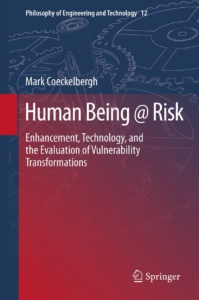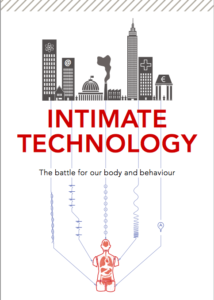On this page I tell the story of how I arrived at my vision of Intimate Computing as Computing with Vulnerability. An academic description of this vision can be found in an abstract I wrote in 2018. A full paper is in the making. You can read more about how this vision connects with Artificial Intelligence and Data Science on a separate page.
With my research I aim to shape a vision of Intimate Computing through the lens of human vulnerability, and contribute to our thinking of what it means to be human in a society where people and technology become more and more intimately connected.
The dress that moved me
My vision of Intimate Computing is a coming together of several strands of inspiration. It originates in 2015 when I crashed very hard: I was burned out. As I was trying to find my grounding again I was searching for what could inspire me to go through the recovery process.
Dancing with technology
Pondering this question, I came across a 3-hour interview with Dutch artist and innovator Daan Roosegaarde on the TV show “Zomergasten” (Summer guests). One of the videos shown by Roosegaarde – the conversation in this TV show centres around TV clips selected by the guest – was this one: a performance during the Spring/Summer 1999 fashion show of Alexander McQueen.
I cannot fully describe this performance in words. But it is the feeling it evokes of how we might relate – dance! – with digital technology, with a kind of softness, provocative yet restrained, that spoke to me.
I did not yet connect it with my ongoing research though. That piece of the puzzle fell into place when I browsed the website of Studio Roosegaarde and came across another dress: INTIMACY 2.0. This is a rather special dress: it becomes transparent upon intimate contact; it is implemented through a heart rate sensor on the wearer, becoming transparent as the wearer’s heart rate increases.
Safety in intimacy
When I talk to people about this dress, it typically sparks very strong reactions – “Oh no, I would never wear that dress!”, or “I would scare the model to make the dress go transparent haha!”. Such responses take a yes-or-no perspective: yes, a dress like this is a good idea, or no, it is not.
What intrigues me about this dress, as an engineer and computer scientist (and woman), is not so much the question whether or not I would wear (the current version of) the dress. What I was interested in is how one might change the behaviour, i.e., the software, of the dress such that it would mediate (see also mediation theory by prof. Peter-Paul Verbeek) my interactions with others in a way that would make me feel sufficiently safe.
And, perhaps more importantly, in trying to answer this question I felt I might shape a vision of how we relate with and through a wide range of intimate digital technologies – technologies that in some sense “come close” to us in our daily lives – that could capture what I felt watching Alexander McQueen’s dance with technology.
Connecting the dots
The second strand of inspiration for my vision of Intimate Computing came from the research of Dr. Brené Brown.
Human Vulnerability

I had come across Brown’s work on human vulnerability before through her popular 2010 TED talk, and started reading her book “The Gifts of Imperfection” (2010) in 2015, trying somehow to make sense of how I had ended up where I was, completely exhausted and unable to do virtually anything.
The book is about living a wholehearted life through practicing the courage to be vulnerable and imperfect. Brown defines vulnerability in her book “Daring Greatly” (2012) as uncertainty, risk and emotional exposure. When we show up and let ourselves be seen, it makes us vulnerable: we share (expose) what we truly care about, not knowing how others will respond and through this we risk getting hurt. And yet, vulnerability is also the birthplace of joy, belonging, love, gratitude, hope, and authenticity.
Intimate Technology
So how does this connect with the INTIMACY 2.0 dress? As I was pondering what the dress might tell me about a vision for our relation with and through intimate digital technologies, I asked myself: what do I feel, looking at the dress and imagining wearing it? And there was one word that came to mind: vulnerable. Sharing something so personal, my feelings and my body, would make me feel vulnerable. And more than that, handing over control over the decision to do so to the technology would make me feel out of control. Very scary and daring at the same time.
Too scary and vulnerable (or oversharing even)? Well… perhaps there is more to say about it. What if we could change the behaviour of the intimate technology to make me feel sufficiently safe to let go of (a little) control and dare engaging with others through intimate technology?
Intimate Computing
Inspired by my research on Socially Adaptive Electronic Partners (SAEPs) which support people in their daily lives taking into account their norms and values, I thought: what if intimate technology would take into account my vulnerability as it supports me in my daily life? Rather than an inflexible all-or-nothing approach to sharing “data” or information about me, the technology should do this in a context-aware and responsible way (for which I’ve also used the term Responsible Data Sharing). Then I might feel sufficiently safe to engage with the new kinds of technology-mediated vulnerability induced by intimate technologies!
And what’s more, by putting vulnerability centre stage when developing intimate technologies, rather than seeing vulnerability as a weakness we could create a digital society that embraces softness and vulnerability.

Of course this is no silver bullet. While developing technologies that address some of our vulnerabilities, we always also introduce novel risks, as argued by prof. Mark Coeckelberg in his book “Human being @ risk” (2013): technologies transform vulnerabilities. Nevertheless I feel that a focus on vulnerability makes these aspects explicit, allowing us to make conscious decisions on how we want to shape our vulnerability with and through intimate technologies.
Starting from the basic idea that the intimate nature of these technologies gives rise to specific kinds of vulnerabilities, I began further developing my vision of Intimate Computing as Computing with Vulnerability. The next step was investigating which other work could provide more grounding to my vision in-the-making.
Related endeavours
It was encouraging to see I was not the only one intrigued by the apparent contradiction of combining the deeply human notion of intimacy with the world of technology.
In 2014, the Dutch Rathenau Institute published a report called “Intimate Technology: the battle for our body and behaviour”. The report discusses concerns and opportunities regarding a wide range of these Intimate Technologies, for example a pill that releases medication only in or near diseased tissue, various in and on-body sensors and quantified self technology, social robots, social media, GPS tracking devices and other surveillance technology, a cuddling device for children in incubators, etc.
High-tech clothing
Moreover, I was delighted to discover that the INTIMACY 2.0 dress is not an isolated example: there are many more researchers and designers working on high-tech clothing and fashion for supporting people in their daily lives and mediating social connection.
I believe this domain can provide a rich source of inspiration for novel research questions. This is because the physical dimension of wearable digital technology makes the connection with vulnerability very direct: INTIMACY 2.0 is literally about exposure and openness towards others. A study of vulnerability in this context could be translated to other types of intimate technology.
I mention a number of inspiring examples of researchers and designers working on high-tech clothing and fashion. Some of my pictures of their work are below!
- Designer and researcher Kristin Neidlinger (Sensoree) develops “therapeutic biomedia, bio-responsive fashion to promote extimacy, externalized intimacy.” For example she has developed the mood sweater which changes colour depending on the mood of the wearer, measured through a Galvanic Skin Response sensor. In this way the sweater helps the wearer communicate her emotions to others. Neidlinger performs her PhD research at University of Twente studying the effects of extimacy.
- Researchers Dr. Geke Ludden and Dr. Angelika Mader from University of Twente and designer Hellen van Rees are developing a robotic vest which helps the wearer assume a proper posture. If it detects the wearer is slouching, it contracts a little which generates a gentle “push” in the lower back to encourage sitting up straight.
- Designer Danielle Roberts (Awareness Lab) has developed the Silence Suit for enhancing and supporting meditation. It is a vest embedded with various body and environment sensors. Through these measurements the vest dynamically adjusts the wearer’s meditation environment, for example the lighting or visual displays.
- FashionTech designer Anouk Wipprecht creates garments that embed digital and robotic technologies to facilitate and augment the interactions we have with ourselves and our surroundings. Her Spider Dress for example has moveable arms on the dress which can extend outwards if it is detected that another person enters the wearer’s personal space. While the INTIMACY 2.0 dress supports the wearer in intimate contact by opening up, the Spider Dress emphasises protection of personal boundaries.
Origins of the term
When I came up with the term Intimate Computing (replacing “research on intimate technology”) to emphasise my focus on the technology’s computational aspects, I discovered that this term had been used by prof. Genevieve Bell and others for a workshop they organised called Intimate (Ubiquitous) Computing with the UbiComp’03 conference.
At the time prof. Bell worked as anthropologist at Intel, and currently she leads the multidisciplinary 3AInstitute (Autonomy, Agency, Assurance) for cyber-physical systems at the Australian National University. I was very glad to find kindred spirits! Although various papers have appeared that combine aspects of intimacy with technology since the workshop was organised in 2003, the term Intimate Computing itself as an overarching descriptor does not seem to have been widely established yet.



